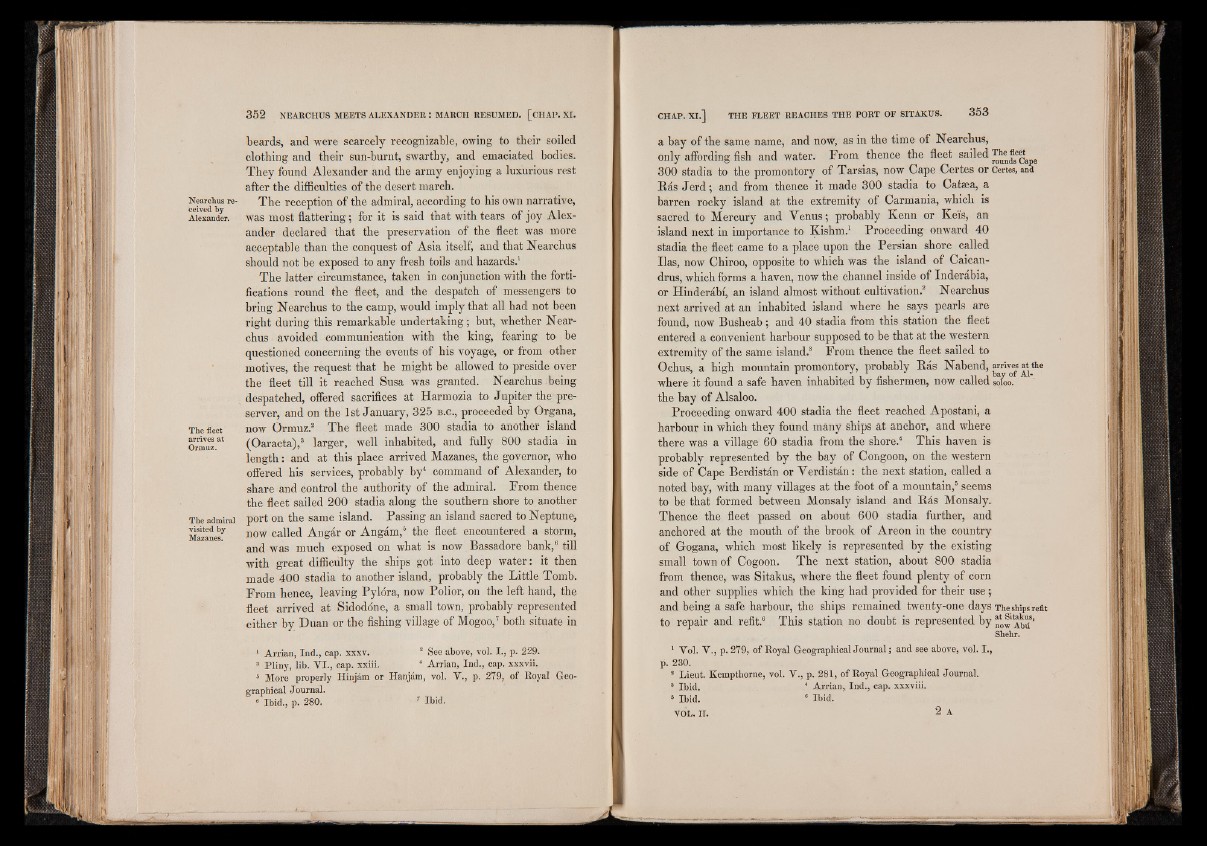
Nearchus received
by
Alexander.
The fleet
arrives at
Ormuz.
The admiral
visited by
Mazanes.
beards, and were scarcely recognizable, owing to their soiled
clothing and their sun-burnt, swarthy, and emaciated bodies.
They found Alexander and the army enjoying a luxurious rest
after the difficulties of the desert march.
The reception of the admiral, according to his own narrative,
was most flattering ; for it is said that with tears of joy Alexander
declared that the preservation of the fleet was more
acceptable than the conquest of Asia itself, and that Nearchus
should not be exposed to any fresh toils and hazards.1
The latter circumstance, taken in conjunction with the fortifications
round the fleet, and the despatch of messengers to
bring Nearchus to the camp, would imply that all had not been
right during this remarkable undertaking ; but, whether Nearchus
avoided communication with the king, fearing to be
questioned concerning the events of his voyage, or from other
motives, the request that he might be allowed to preside over
the fleet till it reached Susa was granted. Nearchus being
despatched, offered sacrifices at Harmozia to Jupiter the preserver,
and on the 1st January, 325 b .c ., proceeded by Organa,
now Ormuz.2 The fleet made 300 stadia to another island
(Oaracta),3 larger, well inhabited, and fully 800 stadia in
length : and at this place arrived Mazanes, the governor, who
offered his services, probably by4 command of Alexander, to
share and control the authority of the admiral. From thence
the fleet sailed 200 stadia along the southern shore to another
port on the same island. Passing an island sacred to Neptune,
now called Angar or Angam,5 the fleet encountered a storm,
and was much exposed on what is now Bassadore bank,6 till
with great difficulty the ships got into deep water: it then
made 400 stadia to another island, probably the Little Tomb.
From hence, leaving Pylora, now Polior, on the left hand, the
fleet arrived at Sidodone, a small town, probably represented
either by Duan or the fishing village of Mogoo,7 both situate in
1 Arrian, Ind., cap. xxxv. 8 See above, vol. I., p. 229.
3 Pliny, lib. V I., cap. xxiii. 4 Arrian, Ind., cap. xxxvii.
5 More properly Hinjâm or Hanjâm, vol. V., p. 279, of Royal Geographical
Journal.
6 Ibid., p. 280. 7 Ibid.
a bay of the same name, and now, as in the time of Nearchus,
only affording fish and water. From thence the fleet sailed The
300 stadia to the promontory of Tarsias, now Cape Certes or Certes, and
Bas Jerd; and from thence it made 300 stadia to Catsea, a
barren rocky island at the extremity of Carmania, which is
sacred to Mercury and Venus; probably Kenn or Kei's, an
island next in importance to Kishm.1 Proceeding onward 40
stadia the fleet came to a place upon the Persian shore called
Has, now Chiroo, opposite to which was the island of Caican-
drus, which forms a haven, now the channel inside of Inderabia,
or Hinderabf, an island almost without cultivation.2 Nearchus
next arrived at an inhabited island where he says pearls are
found, now Busheab; and 40 stadia from this station the fleet
entered a convenient harbour supposed to be that at the western
extremity of the same island.3 From thence the fleet sailed to
Ochus, a high mountain promontory, probably Bas Nabend, arrives at the
where it found a safe haven inhabited by fishermen, now called soioo.
the bay of Alsaloo.
Proceeding onward 400 stadia the fleet reached Apostani, a
harbour in which they found many ships at anchor, and where
there was a village 60 stadia from the shore.4 This haven is
probably represented by the bay of Congoon, on the western
side of Cape Berdistan or Verdistan: the next station, called a
noted bay, with many villages at the foot of a mountain,5 seems
to be that formed between Monsaly island and Bas Monsaly.
Thence the fleet passed on about 600 stadia further, and
anchored at the mouth of the brook of Areon in the country
of Gogana, which most likely is represented by the existing
small town of Cogoon. The next station, about 800 stadia
from thence, was Sitakus, where the fleet found plenty of corn
and other supplies which the king had provided for their use;
and being a safe harbour, the ships remained twenty-one days The ships refit
to repair and refit.6 This station no doubt is represented by ®ow am’
Shehr.
1 Vol. V., p. 279, of Royal Geographical Jo u rn a l; and see above, vol. I.,
p. 230.
s Lieut. Kempthorne, vol. V., p. 281, of Royal Geographical Journal.
3 Ibid. 4 Arrian, Ind., cap. xxxviii.
5 Ibid. ’ Ibid.
VOL. II . 2 A